Type species: Sphinx celerio Linnaeus, 1758.
A genus consisting of about 22 species restricted to the tropics and subtropics of the Old World.
IMAGO: Forewing very elongate, pointed, as is the abdomen. Female antenna clubbed, male antenna rod-like; terminal segment short. Labial palpus smoothly scaled on outer side, but lacking erect hairs present in Deilephila. Scales at apex of first segment regularly arranged on inner side to form an even border; no apical tuft on second segment. Hindtibia with two pairs of spurs, the inner spurs longer than the outer.
Genitalia. Differ little from those of Deilephila and Theretra.
OVUM: Ovoid, small, glossy green.
LARVA: Anteriorly tapering, with retractile head. Abdominal segments 1 and 2 swollen, bearing eye-spots. Horn weakly curved backwards.
PUPA: Proboscis fused with body, laterally compressed and cariniform, similar to that of Theretra. Cremaster long, pointed, without apical spines on the sharp, glossy tip.
HOSTPLANT FAMILIES: Mainly herbaceous plants and climbers of the Vitaceae, Araceae, Nyctaginaceae, Rubiaceae, Polygonaceae and Onagraceae.
UK: Large striped Hawkmoth; Greater silver-striped Hawkmoth, F: Deiléphile Osiris, CZ: Lišaj stříbropásý, FIN: Osiriskiitäjä.
Sphinx osiris Dalman, 1823, Analecta Entomologica: 48.Type locality: Sierra Leone [, West Africa].
[Further details on this species, as well as photos of all stages, can be found on Lepiforum.]
Palaeotropical; Afrotropical region.
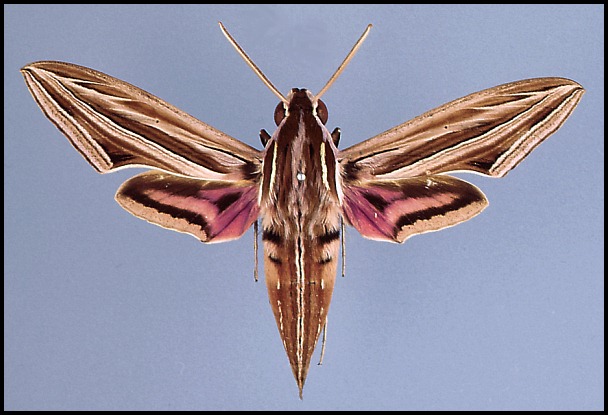
Wingspan: 89--90mm. Very similar to Hippotion celerio (Linnaeus, 1758), but larger and immediately distinguishable by two pairs of black subdorsal basal abdominal patches and the undivided pink median band on the hindwing upperside. Forewing upperside similar to Hippotion celerio, but oblique postmedian band more evenly curved. Antenna of male very stout compared to female. Shows little variation; all European specimens have been of the typical form.
In the male genitalia, uncus as stout as in Hippotion celerio. Gnathos as stout as but much more gradually narrowed to a point than in Hippotion celerio, and rather obtuse. Harpe compressed, slightly upcurved at extreme apex, which is rounded ventrally; dorsal edge notched. Phallus apical process with a rather long and weakly curved row of teeth on the left side and a single subapical tooth on the right.
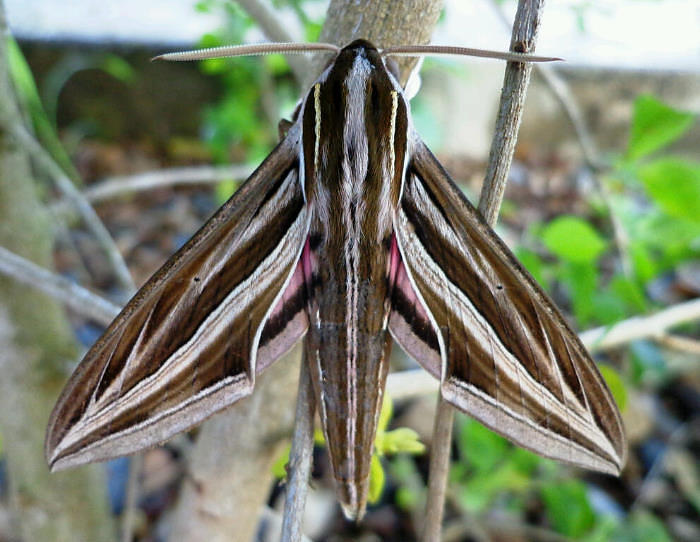
Frequents gardens and public parks with flower-beds or walls and shrubs overgrown with Vitis and Parthenocissus; also, small, private vineyards which are not sprayed with insecticide. Attracted to light.
In the region most have been captured at light mainly between September and November; however, in Israel individuals have appeared as early as June (Müller et al., 2005b).
OVUM: Very like that of Hippotion celerio, but larger.
LARVA: Full-fed, 80--90mm. Dimorphic: brown or green.
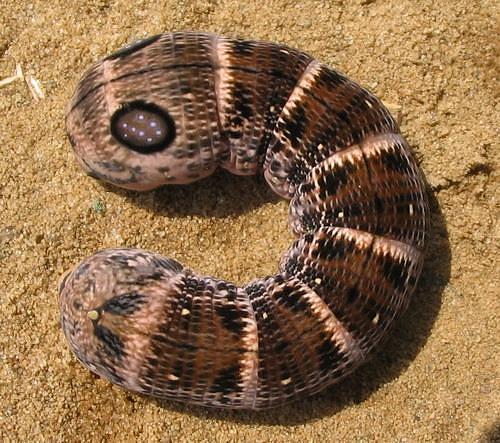
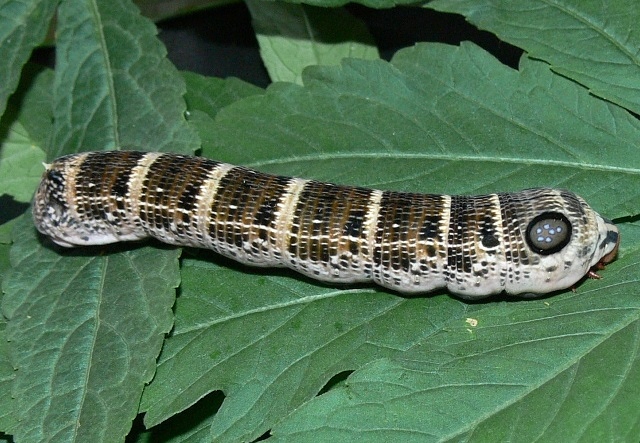
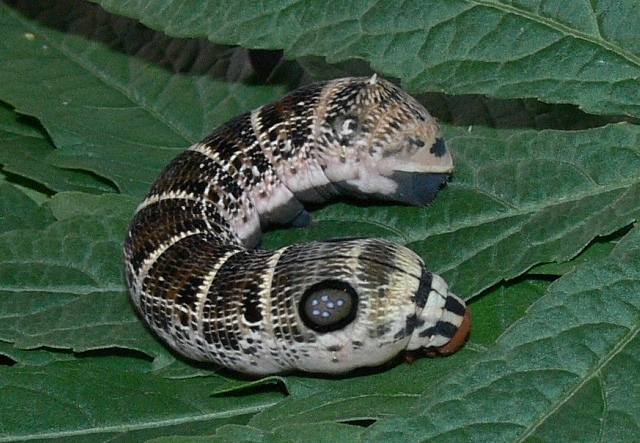
No authenticated records exist from the region; however, if present, most would probably be of the brown form rather than the green; the former predominates in Africa.
In the brown form, dorsal surface to spiracles medium brown with fine, darker brown cross-lines and a fine, black dorsal stripe. Intersegmental areas pale yellow, with two yellow spots on each segment. Fine subdorsal and dorso-lateral yellow lines also present, which merge into a broad, yellow, lateral line in which the white spiracles are located. On abdominal segment 1, a large, black-ringed, purplish brown eye-spot present, containing white-pupilled, purple spots; a smaller eye-spot is sometimes also present on abdominal segment 2, with black patches replacing it on subsequent segments. Ventral surface of body pale brown. Head pale brown. Horn very small (1mm), pale yellow, with a dark tip. The other form has similar black markings but the brown coloration is replaced by green.
Major Hostplants. In Africa, principally Vitis and Parthenocissus spp.
Minor Hostplants. In Africa, Rumex, Polygonum, Impatiens, Cissus, Ipomoea, Spathodea, Fuchsia, Richardia, Spermacoce and various other Rubiaceae.
PUPA: 55--61mm. In shape, very similar to that of Hippotion celerio. Pale greyish brown with black specks. Proboscis projecting forward, laterally compressed and cariniform. Encased in a light brown, loosely spun cocoon on the ground. Does not overwinter in the region.
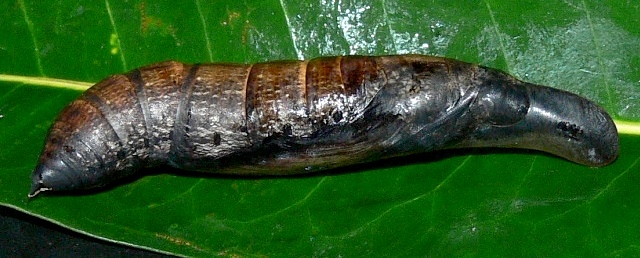
None recorded.
A migrant to North Africa (Rungs, 1981) and southern Spain (Ribbe, 1909-1912; Rambur, 1942; Gomez Bustillo & Fernandez-Rubio, 1976; Vives Moreno, 1981; García de Viedma & Gomez Bustillo, 1981; Pérez De-Gregorio et al., 2001). Significant numbers have been recorded from southern Spain and Gibraltar but the frequency with which this species visits Europe is not known due to its confusion with Hippotion celerio. Ribbe (1909-1912) points out that this species had previously been caught in some numbers at Cadiz.
Also a rare migrant to the Middle East. The first confirmed record was collected in Beirut, Lebanon, in 1960 (coll. NHMUK, leg. Cadiou). Additionally, several specimens have recently (1994-2004) been recorded from Israel during June-September (Müller et al., 2005b). One specimen was found near Eilat (100 m) in mid-June 2001, two specimens near Jericho (-250 m) in September 2004 and another in Neot Hakikar (-400 m) in late July 1994. It has also been reported from the Hoggar Mountains of Algeria, along with several other Afrotropical species (Eitschberger, Mooser & Müller, 2014), as well as Mauritania.
Extra-limital range. Sub-Saharan Africa, Madagascar (Lawrence, 2015) and the Seychelles (Fletcher, 1910; Matyot, 2005).
 Return to species list
Return to species list